Fingernail Lesson for Classical Guitar
By popular demand, a lesson about filing and shaping your nails. This is all about how I shape my nails and might be of interest and a starting point for students. Make sure to see the bottom of the post where I have videos by pros that use a different approach. If you like this lesson consider supporting the site and free lessons. You can watch the above video on my YouTube if you like.
No guitarist is the same – This is not a post on how to file your nails, this is only the way I file mine. This is not a definitive answer and is not a static or unchanging description. This post is how I file my nails for my guitar, sound, style, and personal preference.
Why Use Ramps? Whether your fingernails are curved perfectly in an arch or you create a long ramp, the idea is to have the string travel up the ramp and get pushed into the guitar. Just like a piano hammer pushes the string (rather than plucks it like a harpsichord), your nail directs the string in toward the soundboard when it moves into the palm. See the video above for clarification.
How to find the correct shape for you: Play a comprehensive range of guitar technique when filing your nails. For example: scales, arpeggios, slurs, rest-stroke, free-stroke, sweeping etc. Make sure you can play all the different techniques with ease. Beginner student’s nails are often too long at first making rest-strokes or having a nice arched hand position too difficult. Listen to your tone and find out why/how different nail shapes affect your sound. Experiment with different shapes to discover what works best for you.
Also see my article about Playing Classical Guitar Without Nails.
Photos of Nails for Classical Guitar
- Contact Point – This is where the string makes first contact on the fingertip. I recommend you have both the flesh and the fingernail touch the string at the same time.
- Release Point – After the string travels up the ramp of the fingernail it releases from the nail. You have to make sure it releases easily if you want a good tone and ease of playing.
- String Direction – The direction the string travels up the ramp of the fingernail.
Below is a picture of my fingernails. You can see from the markings where the contact point begins and the release occurs. I’ve tried to keep the perspective from the player’s view so if you hold your hand up in front of your face it will look the same. I’ve also added a flip view for clarity.
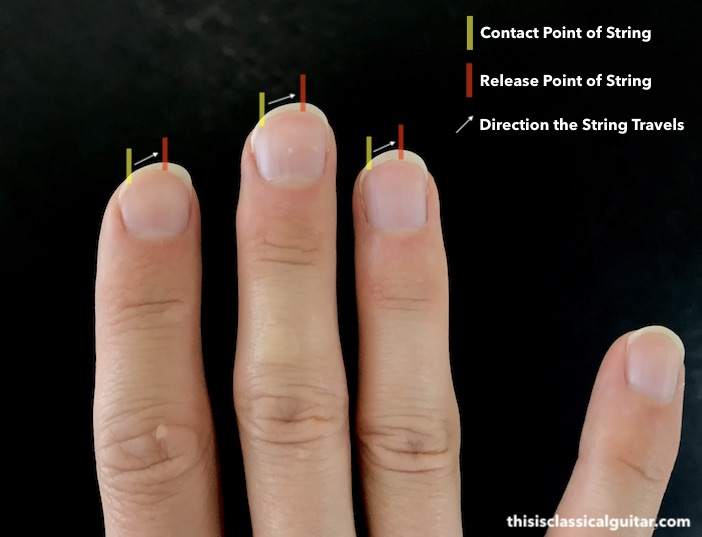
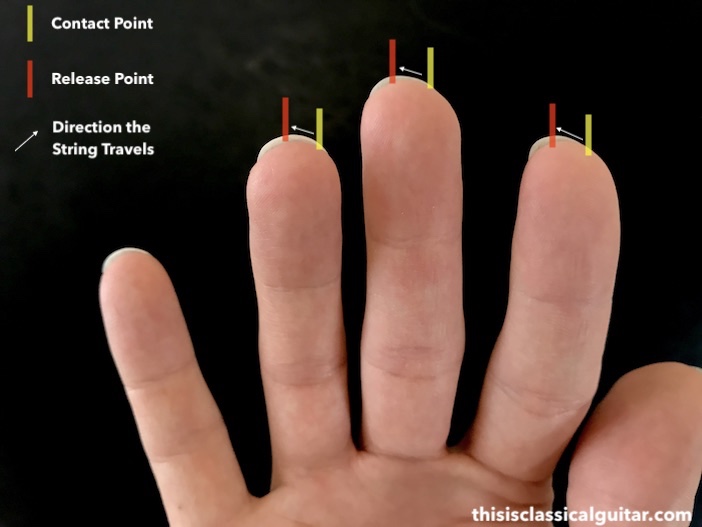
Below is the i fingernail contact point from the player’s perspective followed by an outside view.
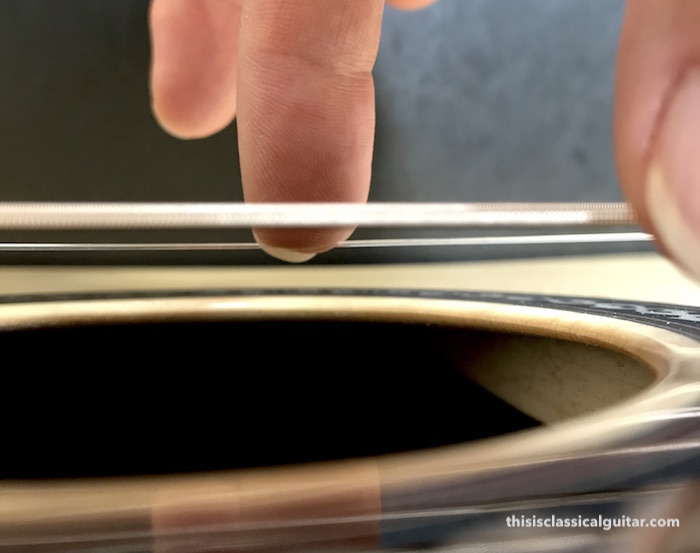
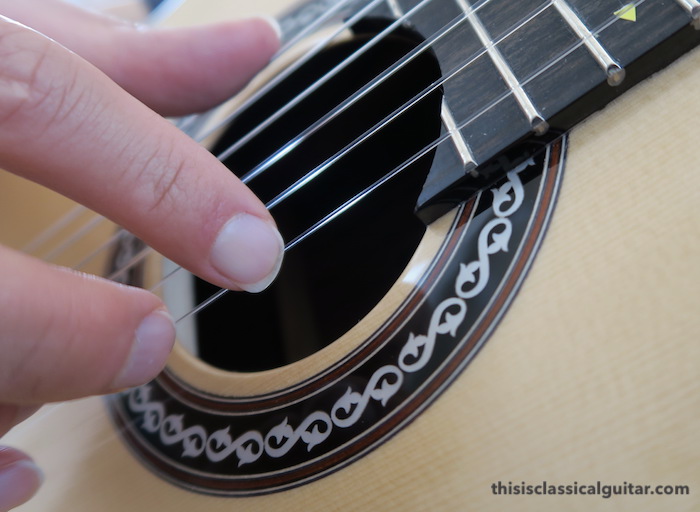
Below is the m fingernail contact point from the player’s perspective followed by an outside view.
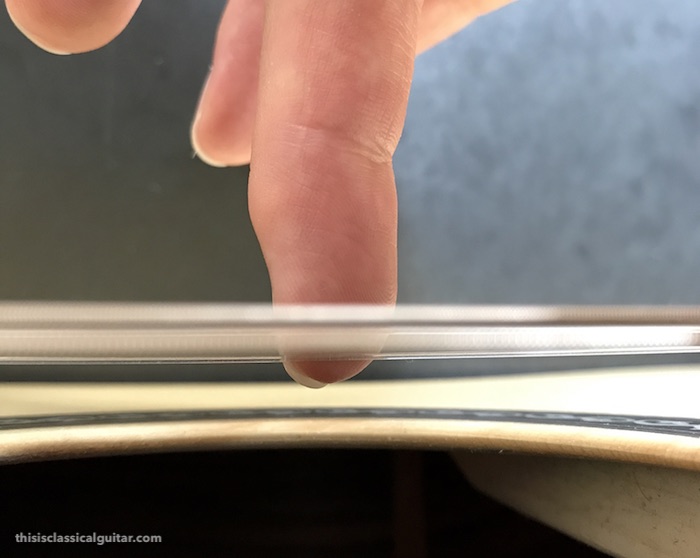
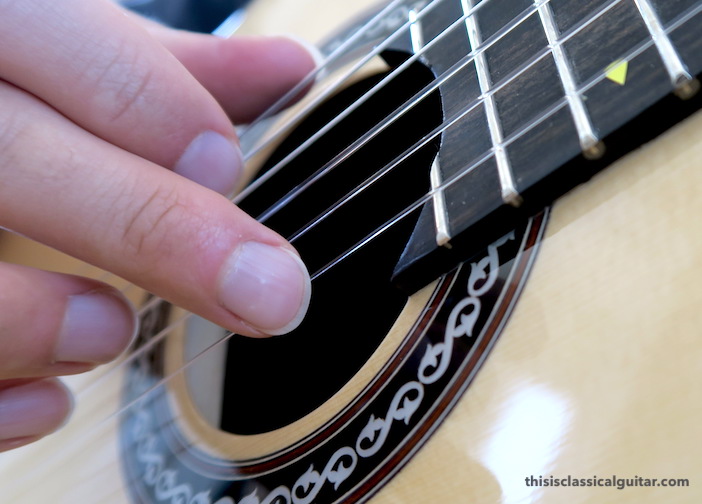
Below is the a fingernail contact point from the player’s perspective followed by an outside view.
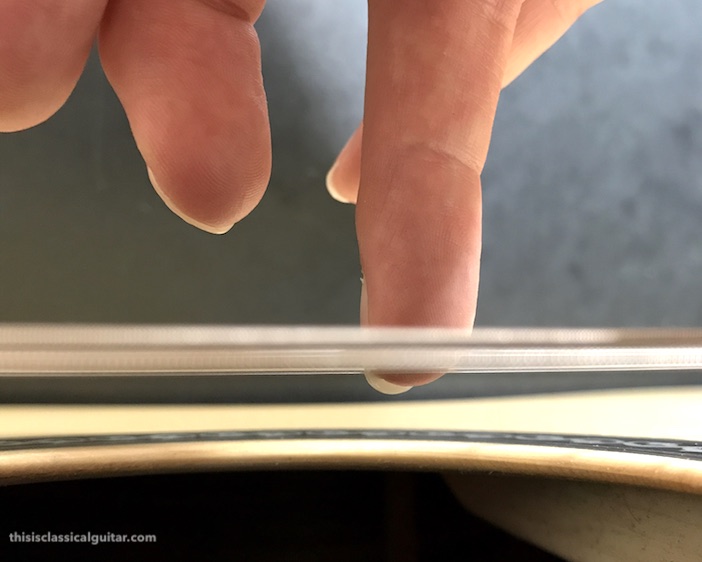
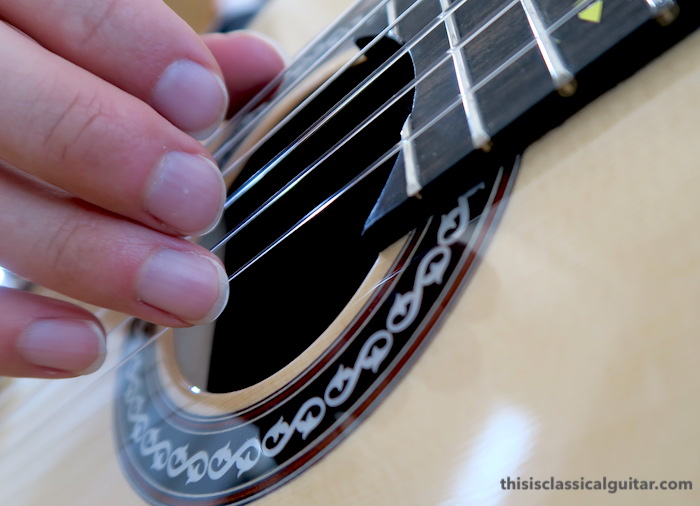
Thumbnail – Here is where players greatly differ on shaping style/direction. Actually, many of my favourite guitarists uses the opposite thumbnail shape that I use. Watch the below video to see my explanation. The reason I use this shape is that when I rest my nail on the string at the contact point it doesn’t move up the ramp until I apply pressure to overcome the resistance. My thumb bends quite far at the tip joint, almost 90 degrees so my shape might differ from your as with the length of the ramp.
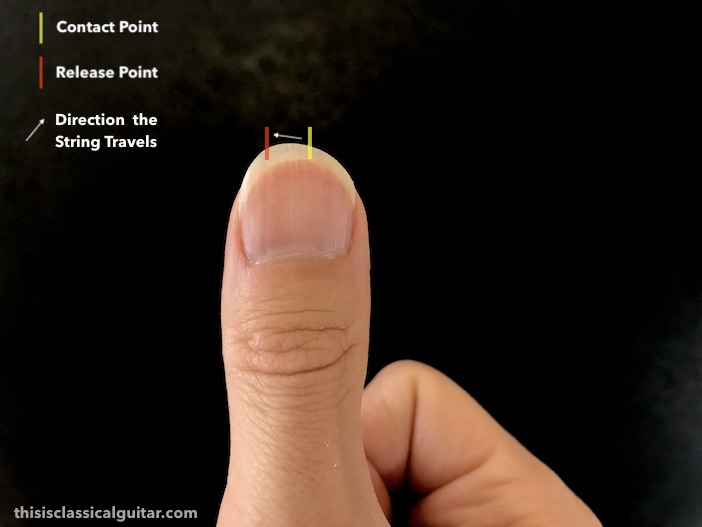
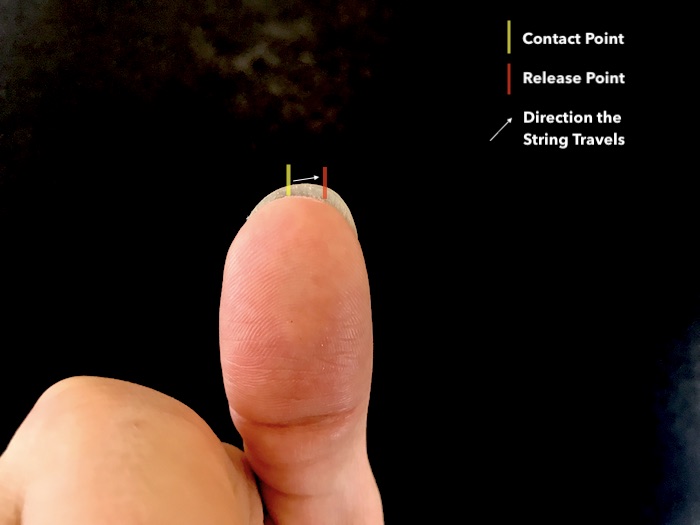
Below is the thumbnail (p) contact point from the player’s perspective followed by an outside view.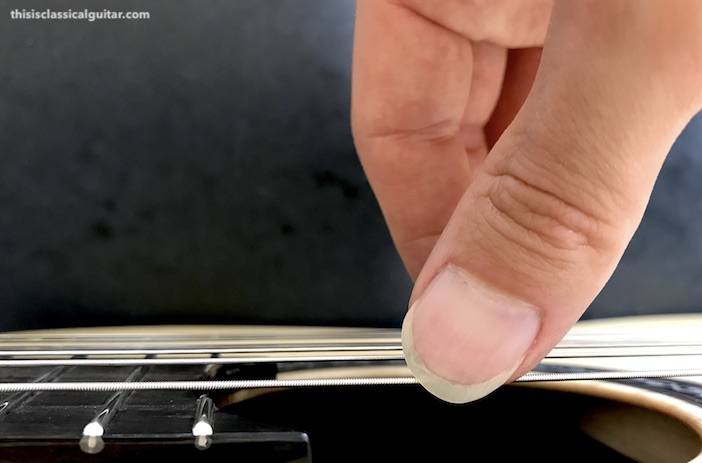
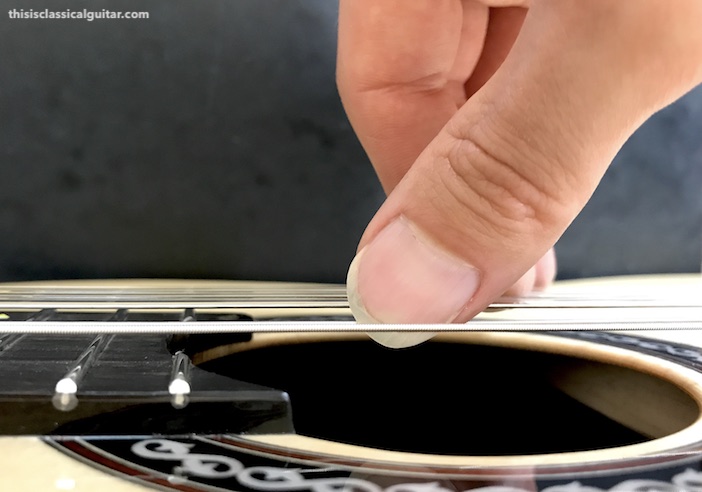
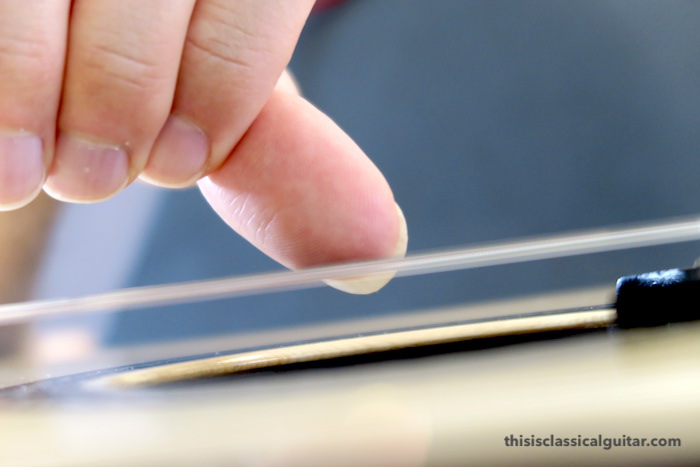
More Lessons on Fingernails by Others
Here’s a Q&A lesson on nails and sound on the guitar via my YouTube.
Hannah Murphy via her YouTube channel. Great video, lots of solid points and I like the descriptions of the shapes at the beginning. The more high quality videos by pros the better people can find shapes specific to them.
Matthew McAllister gives a lesson on filing the nails for classical guitar. This comes via the excellent Siccas Guitars. He has some excellent points about filing and interacting with the string during the process.
The Opposite Shape: A video by Thomas Viloteau with the opposite shape. One of my favourite pros, Viloteau talks about filing and shaping the right hand finger nails. He shapes his nails in the opposite direction to mine which is great as it shows the variety. Clearly it works for him!
Tatyana Ryzhkova gives a lesson on Nail shape, length, and care via her ‘Ask Tatyana’ segment. More of a discussion which is good because context is so important to understanding how to file your nails.
Fingernail Gear via Amazon
Crystal file: Crystal Nail File – I use this first instead of the 2 shaping sides below. Then polish with the buffer sides on the revlon shape & buff.
Multisided nail file: Any multi-sided file with a buffer will help shape and finish nails. I start with a crystal file to shape and then smooth and buff with a multi-sided buffer.
Micro Mesh: Even better, micro mesh papers seems to last longer and you can be more specific about the grit level. I like the 12,000 for buffing. Plus you can really get under the nail since it is so pliable.
Healthy Hoof: Healthy Hoof Intensive Protein Treatment – this is great for two reasons. One, it keeps the nails moisturized which will stop the nail from cracking or breaking. Two, the protein help the nail grow thick and strong.
Protect + Improve: Healthy Hoof Lacquer + Protein Treatment: high gloss protectant, leaves an ultra shiny, satin finish with a strong UV protectant for strong, healthy nails
Books on classical guitar nail shaping: Most guitar technique books feature some info on nail shaping. You might want to check out Scott Tennant’s Pumping Nylon or Kappel’s Bible of Classical Guitar Technique. Check out the sheet music by other publishers on my sheet music page.
Disagree?
I know many of you will completely disagree with my advice. However, please remember that this is how I shape my nails and I am not recommending you do exactly the same. Everyone’s hands, technique approach, and sound are different so, therefore, our nails shapes must also be different. What’s your thoughts and constructive criticisms on this?
More Languages: Leçon sur les ongles: comment limer et façonner vos ongles pour guitare classique. Fingernagel-Lektion: So feilen und formen Sie Ihre Nägel für die klassische Gitarre. Урок по ногтям: как подать и придать форму ногтям для классической гитары. फिंगरेल लेसन: शास्त्रीय गिटार के लिए अपने नाखूनों को कैसे दर्ज करें और आकार दें। 爪のレッスン:クラシックギターの爪を削って形を整える方法。
More lessons
Find more free classical guitar lessons at the Lesson Archive Page.
- Fingernail Lessons
- Fingernails for Classical Guitar: How I Shape My Nails – Start Here
- Thomas Viloteau on Nails and Shaping
- Filing nails with Matthew McAllister
- The Ping-Pong Ball Fingernail Repair Guide by Samuel Laroche-Pagé
- Related Lessons
- Right Hand Position & Technique – 4 Video Lessons, Photos, Tips – Start Here
- Right Hand Tone Production – 2 Video Lessons – Start Here
- Right Hand Fingering Lesson Parts 1-4 – 4 Video Lessons
- Right Hand Planting (Preparation)
- Should Beginners Use Rest or Free Stroke?
- Essential Beginner Lessons – Refer back to these lessons often
- Basic Technique Overview Video – Slideshow of Photos, Tips, & Diagrams
- Sitting Position for Classical Guitar – Video, Photos, Tips, Diagrams
- Right Hand Position for Classical Guitar – Video, Photos, Tips, Diagrams
- Left Hand Position for Classical Guitar – Video, Photos, Tips, Diagrams
- Tips and Advice for Beginner Classical Guitarists – Video, connects the above lessons
- 10 Classical Guitar Lessons for Beginners – Video, General Tips





Hi, I just started to learn classical guitar on my own, your blog is a great source for beginners, thank you so much for providing all this content, this is really helpfull and inviting to start (and that’s why I have started !).
My right thumb is very straight and not hyperextended. When I look your pictures from the “players’s perspective”, my playing position is not so different. I can manage the same position with the curve of the hand. However the pictures with the player in front of the photograph the thumb is in hyperextention, thus I am thinking the sound can’t be the same because it creates a different angle. And depending of my tests, I can hear a kind of horizontal slipering on the string which is (I think) not good (nice to hear) for the metalic bass strings.
It really makes me so confused and frustated. I even noticed I tended to break the curve of my methacarpophalangeal joint (I push the joint to the palm), I guess this is because I inconsciously try to angle my thumb differently on the bass strings. I try to find pictures/videos of people with the same thumb than mine. If you would have any recommendations… It’s a shame, I really love playing the guitar 🙁 Wish you a successful continuation
Longterm experimentation is key, also watch the videos from others that I’ve included as my angle and shape might be different. You may have to shorten the contact area on the nail to avoid excessive noise on the bass strings. Also, just relax and give it time, if we start hearing something and fixating on it it becomes bigger than it might be. Not to underplay what you said, though, of course address the issue.
Hi Bradford, thank you so much for your reply ! Just after writting you, I cut all my nails because I was a bit bored and then I couldn’t play at all because everything was different I couldn’t make a sound as well as the one with my nails, so I was more bored with finding a good position and I lost motivation… I saw your reply and it gave me hope that it’s just a period of trials and training, I think I have found an in between position enough comfortable and engough “accepteble sound”, however I admit I can’t go back to playing guitar again despite my nails are very long now so I can try more different shapes… I guess I have to find a routine or just to leave the guitar in the middle of the living room outside its bag everyday (even if I’m a bit worried about dust?) in order to see it and just grab it to play… thanks again, have a lovely week !
Thank you for writing this article. I’ve been contemplating returning to playing the guitar (post hand surgery after not being able to use my hands for years) and this is also helping me navigate various possibilities in experimenting with (overlay) products since I’m a new nail technician (mostly manicurist).
As an electric guitar player fo 20 years I know my guitar. However, fingerpicking on a classical is like learning a new instrument. My nails have grown long enough and I’ve been playing classical for about 2 months now. I was trying without the ramp first, just a nice rounded edge. But what I noticed is that I was fighting the string more. Since adding a very slight ramp I feel much more control over the sound and feel of how I play.
I’m guessing these amazing players that don’t use the ramp have just gotten good at playing countless hours without it. But it almost feels like cheating, but really it’s just science and following the path of least resistance.
Now I’ve just got to refine my ramp. Thank you Bradford!
Its clear that with an attack angle of about 45° there is some sliding on the string with the nail (and thats why the contact point and the release point are different spots). I find it causes quite a bit of scratching sound especially when picking wirewound strings. Do you have this problem? Im currently experimenting with the shape of my nails but i cant rid myself of the scratchy sound. Maybe im being too picky? In the video with Thomas Viloteau after he filed his nails i still find his sound very scratchy…
When playing on the bass strings with i, m, a you can tilt the hand angle so the nails pluck more perpendicular to avoid the scratchy sound. It’s a very subtle adjustment but makes a difference in those specific situations where you find yourself on bass strings and need a clean sound. Sometimes when pros are on a stage the audience can’t really hear the scratchiness though.
I have problems playing with my thumb. I always file the nail the opposite side, but I’ll try your way and see if helps me.
BTW this video was extremely helpful! Thank you.
I have a thumb nail that has a crease through the middle of it leaving the left side of the thumb with a hook. I tend to play with the thumb itself and with very little nail. I have to forgo the relaxed thumb position and play with a somewhat arched thumb shape so the nail doesn’t snag. (Thankfully this does not tense my right hand) I would however like to get a clearer tone. Some recommend that with a hook nail it is better let the nail grow longer and others say it’s better shorter. Any suggestions on length and or shapes? (I’m not interested in heating the nail to correct the shape). Thanks.
Well, first off, there are many oddities with everyone’s nails, even with pro players. So yes, experiment with different lengths and shapes (it’s time consuming to experiment, I know!). I often find that students also need to examine their entire hand and sitting position as well since this affects all the angles. In the end, having a teacher carefully examine your technique and nails is the most helpful. Online learning is only a supplement.
Thank you Brad for all the hard work it undoubtedly took to put all this together. Thank you for all you do for us mere mortals!
Ed
Glad you enjoyed it!
I found this web article on the way you file your nails very interesting but your video on it does’nt appear like the two others… Wandering why… I would realy like to see it. Thank’s,
Cadie
Fixed!
Thank you very much, now I can and will look at it…
Hi! I am a newbie and I am complimenting your terrific instructions / books with Frederick Noad’s book. I am trying to replicate the sounds/tones in your videos but I am having an issue with fingernail scratching sounds on the strings. Can you please confirm if this is mostly to do with my fingernails not being polished enough or a bad shape (they are just the normal shape at the moment). My technique would appear to be sound (re your advice), so I am thinking it may be the nails. Many thanks, hope you can advise.
Could be your nails. I mean there is some nail sound when we play but it usually isn’t heard by the audience. Study the article and a few other videos and see how it goes. Make sure to have great nail files with polishing sides. Also, some strings are noisier than others. A clear nylon string will have less noise than a rectified string or composition (sometimes).
Thanks for your feedback. I will try and improve the nails and see how it goes.By the way, I am using Augustine strings. Look forward to progressing through your Volume 1.
My issue is that my nails curve- especially my thumb nail. It curves to the point where the flesh of my thumb hits the string instead. How can I flatten it out without breaking it?
Hello Bacon Bacon…I am in no way a professional performer. That said, I (used to) play out a whole lot, weekly in fact, while I tended to my sheep farm here in central Maine.
So, your thumb nail is not, in your opinion, acceptable. Well, then you’ve got to work with what you’ve got, not with what you wish you had. Who cares, other than you, that your nail is “different”. I suggest you work with it and get ‘your’ sound. You might be surprised with what you come up. Work with what you’ve got, chill, be open, chill…you will get a wonderful sound that will be yours. Your thumb is not a liability, it’s a gift. Just my 2 cts.
Charlie
Back in the days when I started getting my nails “done”, I was laughed at. Right now it is actually trendy among guitar players in my hometown.
What happens if you generally don’t have nails? I very very short nails, mainly because typing with long nails is a big pain. Having just bought my first guitar today, I’m hoping it’s not going to be a big problem…
BTW thank you for the tutorials so far. 🙂
I usually start my students without nails anyway so I wouldn’t worry about it for a year or two.
Here is my problem: First of all, I am a left-handed player, but that’s not the problem. I have an unusual thumb nail that folds down somewhat on the side that makes contact with the string. If I point the tip of my thumb towards me, instead of the nail looking like this; ( it will look like this: (_ . That’s an exaggeration, to be sure, but I am limited by the keyboard symbols! Thus it will quite often snag the string creating a God-awful double-forte TWANG in the middle of a nice soft piano passage. I’m wondering if I should cut the nail short and glue on a guitar nail. What do you think?
My thumb nail is oddly shaped as well, making filing and shaping quite the challenge.
i play fingerstyle guitar on a steel string and keeping my nails right to perform every day is the worst chore out of everything. i get them just right and it only lasts 2 days, not to mention my thumbnail frequently needs a fake nail glued on because all the repetitive bass plucking shaves it down faster than it grows. wish i could just have adamantium nails surgically installed.
then oftentimes i cant get the good shape even trying. first it will have this overplucking going on where the nail gets caught too easily, making it very hard to play. then i will reform it only to get a scraping noise everytime i pluck. then i reform it and it becomes too short and i start missing strings and getting a raw fingertip. then naturally anytime i agree to help a friend move furniture or something i shatter one of my nails. haha this is the worst part of playing fingerstyle guitar
I just started learning classical guitar. My teacher says the right thumb initially contacts the thumbnail at its middle, and then slides off on the left side of the thumb. This whole fingernail shaping thing is really vexing a beginner, but it’s so important to get the shape right.
Can’t believe I’m standing in a pub searching the web for nail care but hey 🙂 Thanks for the information, really helped! Played electric for many years but new to classical – as I have the brain capacity of Mr Bean the images did it for me! Cheers.. Graham.. Liverpool/England
Thanks, this is useful info for someone who has never filed their nails. While learning “Recuerdos de la Alhambra” I figured I’d better learn a tip or two!
Heavy credits and active link at the very top of the article please! Otherwise go for it.
Thanks.
I am a newcomer to the guitar, at 73 years of age, and I wish to learn classical (I am also attempting to make a classical guitar). I did read that one way to define your nail shape was to fold a piece of emery paper 2″ square and fold it in half, place this over the G (3rd) string and then proceed to ‘play’ with your hand. This will wear the nail that is in contact with the string and give to a guide on where and what shape to file them. Like every thing else with classical guitar I find nail shaping confusing as there does not appear to be any definitive answer.
Tony
Good luck learning Anthony. I am 52, have been playing since you was 16, and finger picking since my late 20’s, and feel like I’m still learning everyday.
Don’t let frustration get you down. I was very frustrated when learning in the beginning, and often wanted to give up, but never did. I did have one set back where I was unable to play from around 24 years old to around 26. I worked construction, installing the finished trim in houses and one day I sliced the very top of my long finger on my noting hand. I could not stand to put it on a string, and I actually have up and thought my playing days were over. However my love of playing got the best of me, and a couple years after doing that, determined to play again, I would sit for hours at night forcing myself to note on a different part of the end of that finger. If I look at my hand with my palm facing me the cut was right at the corner of the nail on the left when viewed from that orientation, and to this day the callous on that finger is from about midway of the nail and extends to the right, whereas before the accident it had been all the way across the tip.
I said that to say this…. DON’T STOP TRYING NO MATTER WHAT HAPPENS! I firmly believe if were to lose fingers I would still have to find a way to play guitar….it’d be hard to go through life playing because it is what defines me as person after so many years.
Don’t forget that if you perform in halls your sound is less harsh from the further from the guitar you get. Sometimes the sound your after is not the one you hear but rather the one from the back of the hall.
Depends on how/where you play…
This is the most comprehensive and detailed coverage of nails I have seen to date. A much needed resource, many thanks for putting it together in such a thorough manner!
Broke my thumbnail today, now I will be aware of bumping it for at least another week, and I’m sure other players have been there and vowed to catch a nail snag before this happens.
OMGoodness! I have had my ramp going the wrong way for 30 yrs!…. being left-handed, I mis-read all the pix that have ramps. Thanks. I will dwnld and save the pix for future referrence.
Gord, I a right handed player and have, like you, ramped my nails in the opposite direction. Just for fun, I’ll ramp them in the direction of this description and see if it makes a difference.
My luthier has told me to not use my nails at all. I keep my pretty short so they are barely there yet I feel the tone and color is much better with nail than without.
it is very subjective! the important thing is to play very well!!
Yes, the thumb is the one most people differ on!
No argument here. I do mine about the same, but my thumb seems to contact the string from the opposite direction! Hmmm…
“…but my thumb seems to contact the string from the opposite direction…”
Exactly what I thought!….
yep!! =)
Yeah my thumb strikes the opposite side his does as well
OK, I like this… BUT!
The most important thing about nail shaping is that you don’t lose sight of playing the guitar. The seriousness with which I file my nails depends dramatically on how much time I have to play guitar, as that goes down, so does my ability to shape my nails. Normally, I just smooth them a bit, keep them the right length and go at it.